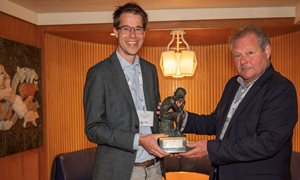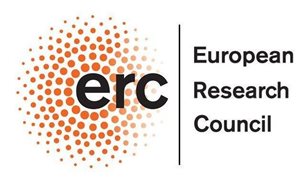 Researchers from the Radboud University and the Hubrecht Institute have developed a human model in which they use organoids, or mini organs, to study the function of specific genes that are mutated in liver cancer. Using this method, they have found that mutations in BAP1, a gene commonly mutated in liver cancer, changes the behaviour of the organoids, which may make them more likely to be invasive. Their results were published in the scientific journal Cell Stem Cell.
Researchers from the Radboud University and the Hubrecht Institute have developed a human model in which they use organoids, or mini organs, to study the function of specific genes that are mutated in liver cancer. Using this method, they have found that mutations in BAP1, a gene commonly mutated in liver cancer, changes the behaviour of the organoids, which may make them more likely to be invasive. Their results were published in the scientific journal Cell Stem Cell.
Publication in Cell Stem Cell: Probing the Tumour Suppressor Function of BAP1 in CRISPR-engineered Human Liver Organoids.
On the photo: Lisa van Voorthuijsen, Rik Lindeboom and Michiel Vermeulen.
This research is a collaboration between the group of Michiel Vermeulen, theme Cancer development and immune defense, the group of Hans Clevers at the Hubrecht Institute, the group of Jacco van Rheenen at the Dutch Cancer Institute, the group of Peter Peters at the Maastricht Multimodal Imaging Institute and the Department of Pathology at University Medical Center Utrecht.
Organoids and cancer research
Organoids are mini organs that can be grown in the lab, from a very small piece of tissue derived from a variety of organs. They have been used in cancer research for a few years, mainly by comparing organoids derived from healthy organs to those derived from tumors. This approach however is not suitable to investigate the function and the role of specific genes that are already known to be mutated in cancer. In order to learn more about tumor formation, there was a need for a clean model in which organoids with and without such mutations can be compared.
New model
The researchers developed a new model in which organoids from the healthy human liver are genetically altered using molecular scissors called CRISPR/Cas9, to study the function of the genetic alteration in tumor formation. “Studying the function of such mutations in tumor formation is especially important in liver cancer,” says Benedetta Artegiani, one of the researchers, “since it is a very heterogeneous type of cancer: a wide variety of mutations in different genes are found in different patients.” Until now, the function of many of these genes in tumor development remains unknown. The newly developed model therefore is a valuable tool to address the function of specific genes in liver cancer formation.
BAP1
The model was exploited to shed light on the function of BAP1, a gene that is mutated in approximately 15-20% of liver cancer patients and of which the specific role in liver tumor development so far remained unknown. The researchers found that organoids in which BAP1 was mutated had very different characteristics compared to the healthy organoids: they turned into solid masses that grew faster, were more motile and fused with other organoids. These observations resemble the characteristics of a more invasive malignant tumor. Furthermore, these changes in organoid morphology and behavior can be reversed by adding normal cells. Credit: Benedetta Artegiani, © Hubrecht Institute BAP1 to the organoids. In addition, the researchers made organoids with mutations in four genes that are often mutated in liver cancer, and organoids in which a mutation in BAP1 was added. They found that while the organoids in which the four common liver cancer genes were mutated only formed benign adenoma when transplanted into mice, the organoids in which BAP1 was also mutated formed malignant tumors - the so-called cholangiocarcinoma.
Choosing the right model
By combining different approaches- microscopy, time-lapse imaging and “multi-omics” (RNA, DNA and protein-based) techniques, the researchers dug into the mechanisms through which a mutation in BAP1 can affect tumor development. They found that mutating BAP1 changes which genes are active in the organoids and that these changes in gene activity can be reversed. “These changes may depend on the cell type in which BAP1 is mutated,” says Artegiani, “which may explain why the previously described functions of BAP1 differ between different types of cells. This underlines the importance of studying gene function in a relevant model, derived from the organ and the organism of interest.”
Tumor modeling
The researchers show mutations in BAP1 are important for the transition from a benign to a malignant liver tumor. Furthermore, they show that their model can be used to model liver tumors by mutating single genes. Since the model makes it relatively straightforward to manipulate healthy human organoids with CRISPR/Cas9, it may be used to study the function of the many genes with unknown function in liver cancer, both individually and together, to look at the combined effect of different mutations. This will provide more insight into the development of liver tumors.
Related news items

T cell immunity is directed by tetraspanin CD53
5 July 2022 T cells are immune cells that are key for the defense against pathogens and cancer. T cells depend on the membrane protein CD45 to initiate T cell receptor signaling, but how CD45 is controlled at the molecular level is poorly understood. go to page
A single protein complex balances the very first lineage decision of cells in human: towards foetus or placenta
21 June 2022 The international group of researchers spearheaded by Dick Zijlmans and Hendrik Marks together with colleagues from KU Leuven, examined which proteins are associated with the chromatin and how this affects gene transcription. go to page
Dutch Society of Clinical Chemistry Science & Innovation Award for the team of Hans Jacobs
14 June 2022 The team of Hans Jacobs pioneers on the development of personalized diagnostics to measure minimal residual disease in patients with multiple myeloma. go to page
European grants for groundbreaking Radboudumc research Professors Roshan Cools and Peter Friedl receive ERC Advanced Grant
26 April 2022The European Research Council (ERC) is awarding grants to Roshan Cools and Peter Friedl, both professors at Radboudumc. While Cools will investigate how brains control behaviour in (stressful) situations, Friedl will work on developing a new cancer therapy.
go to page
Saponin-based adjuvant-induced dendritic cell cross-presentation is dependent on PERK activation published in Cellular and Molecular Life Sciences
20 April 2022 Lisa Huis in ‘t Veld, Nataschja Ho and colleagues from the team of Gosse Adema published in Cellular and Molecular Life Sciences that Saponin-based adjuvant-induced dendritic cell cross-presentation is dependent on PERK activation. go to page
Rubicon grants awarded to three RIMLS researchers
19 April 2022Three researchers have received Rubicon funding from NWO/ZonMw. This will enable Elke Muntjewerff, Laura de Vries and Laurens van de Wiel to do research at a foreign research institute for the next two years.
go to page